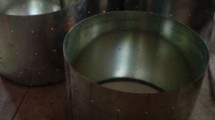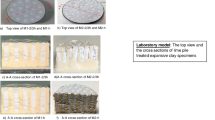Abstract.
Swelling of expansive soils and associated movements of foundations cause serious problems to many structures. With the existing expansive clays in Ankara, capital city of Turkey, some light buildings, road pavements and buried pipelines have shown some damage. To avoid such damage, prior to construction expansive clays may be stabilized. There has been little work concerning the stabilization of Ankara Clay and this was concentrated on the lime mixture technique. The main objective of this study was to investigate the performance of the lime column technique on laboratory-scaled models to improve the physical, swelling, strength and consolidation characteristics of this clay. The characteristics of the treated samples were determined in terms of distance to the column and curing period. In general, the results suggested that the most effective zone for the lime migration developed at a distance approximately twice the column diameter and a curing period of 28 days generally seemed to be sufficient. Application of the technique provided a gain in strength between 40 and 80% and resulted in an increase in pre-consolidation pressure and a decrease in the compressibility characteristics of the treated soils, depending on the distance to the lime column. Construction of the column caused a drastic reduction in swell pressure, between 40 and 75%.
Résumé.
Le gonflement des sols expansifs et les mouvements associe amener les problèmes sérieux sur plusieurs constructions. A cause d'existence des argiles expansive à Ankara, la ville capitale de la Turquie, certains bâtiments légers, chaussées des routes et les lignes de vie étaient confrontée aux dommages. Pour éviter de ces détériorations avant de la construction, les argiles gonflant peuvent être stabilisé. Il y avait peu des études concernant la stabilisation des argiles d'Ankara et ils étaient centralisés seulement sur la technique d'introduire de chaux. L'objective principal de ce travail est d'examiner la performance de technique colon chaux a une échelle laboratoire pour améliorer des caractéristiques physiques, de gonflement, de résistance à la compression uniaxiale et de consolidation de ces argiles. Le caractère des échantillons traité est déterminé suivant la distance au colon et le période de cure. En général, les résultats montrent que la zone la plus efficace pour migration de chaux correspond à peu près le double de diamètre de colon, et un duré de cure 28 jours semble suffissent. Apres l'application de la technique, la vigueur des spécimens traité s'élève entre 40 au 80%. Un accroissement en pressure de pre-consolidation et un affaissement de la compressibilité selon la distance au colon chaux sont aussi décidé. La construction de colon provoque une réduction radicale en pressure de gonflement entre 40 et 75%.
Similar content being viewed by others
Author information
Authors and Affiliations
Additional information
Electronic Publication
Rights and permissions
About this article
Cite this article
Tonoz, .M., Gokceoglu, .C. & Ulusay, .R. A laboratory-scale experimental investigation on the performance of lime columns in expansive Ankara (Turkey) Clay. Bull Eng Geol Environ 62, 91–106 (2003). https://doi.org/10.1007/s10064-002-0176-z
Received:
Accepted:
Issue Date:
DOI: https://doi.org/10.1007/s10064-002-0176-z




